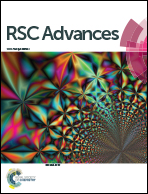Cu2O NPs decorated BiPO4 photo-catalyst for enhanced organic contaminant degradation under visible light irradiation
Abstract
The surface of BiPO4 was decorated with Cu2O nanoparticles (NPs) (hereafter designed as Cu2O/BiPO4) via an interfacial self-assembly method. The physical and photophysical properties of the Cu2O/BiPO4 hybrid photocatalysts were characterized by X-ray diffraction (XRD), scanning electron microscopy (SEM), transmission electron microscopy (TEM), energy dispersive X-ray spectroscopy (EDX), X-ray fluorescence spectrometry (XRF), UV-vis diffuse reflectance spectroscopy (DRS) and photo-electro-chemical (PEC). Compared with bare BiPO4 and Cu2O, the Cu2O/BiPO4 composites exhibited significantly enhanced photocatalytic activity for methylene blue (MB) degradation under visible light irradiation. The 5 wt% Cu2O/BiPO4 showed the highest photocatalytic activity under visible light irradiation, which was about 12.25 times that of BiPO4. Significantly, the superior stability was also observed in the five cyclic runs. The Cu2O/BiPO4 hybrid photocatalysts exhibited dramatically enhanced photo-induced electron–hole separation efficiency, which was confirmed by the results of photocurrent measurements. On the basis of the experimental results and estimated energy band positions, the mechanism of enhanced photocatalytic activity was proposed.


 Please wait while we load your content...
Please wait while we load your content...